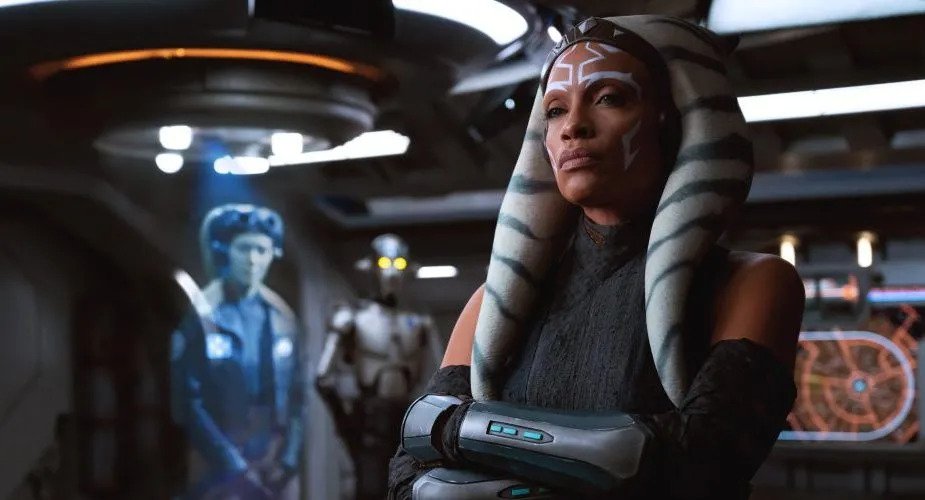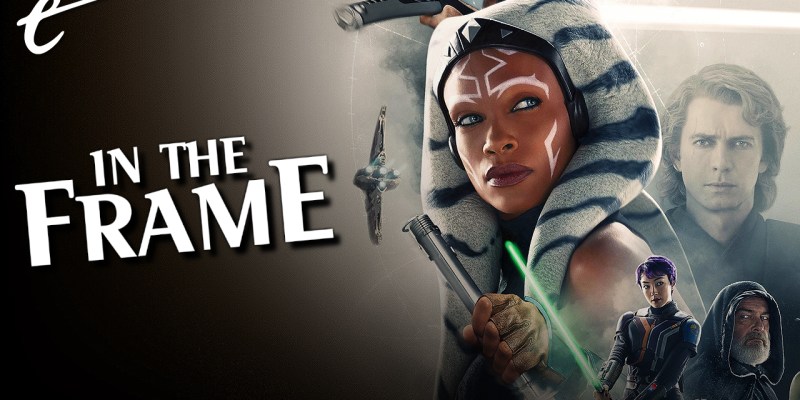To its credit, Ahsoka seems to propose its own vision of Star Wars.
This makes sense. It is the brainchild of writer, director and producer Dave Filoni. Filoni is an interesting character. He was personally poached from Nickelodeon by George Lucas, and was responsible for overseeing The Clone Wars and the first two seasons of Rebels. Filoni’s personal association with Lucas has become part of his mythology, as has the relative success of The Clone Wars and Rebels within the larger Star Wars brand.
Filoni has been positioned as “George Lucas’ padawan” and described as the man who “rescued Star Wars.” Filoni has been confirmed to direct the upcoming “climactic event feature” that will tie together The Mandalorian, The Book of Boba Fett and Ahsoka into a single gigantic crossover. Given the track record that Disney has had producing new Star Wars feature films in the wake of The Rise of Skywalker, there is a very real possibility that Filoni might direct the next theatrical Star Wars film.
Related: Ahsoka’s Age in Every Star Wars Show
As such, Filoni has been positioned as a potential guiding architect for the larger Star Wars franchise. His vision will potentially shape what Star Wars can be. As such, it’s worth unpacking what exactly that vision looks like. To its credit, Ahsoka is at least more coherent and more functional than other recent Star Wars shows like The Book of Boba Fett, Obi-Wan Kenobi or the most recent seasons of The Mandalorian. However, it becomes a bit tougher to figure out what it actually has to say.
To put it simply, Ahsoka is fixated on continuity. It is a show that is built around the audience’s assumed familiarity and attachment to the characters that it depicts and the story that it tells, to the point that Ahsoka itself is completely uninterested in either building or demonstrating emotional attachment. It presumes that the audience has shown up already invested in these characters, and that simply showing them on screen running through fetch quests will elicit an emotional response.
To be fair, this is not a problem unique to Ahsoka. A lot of modern pop culture is built around this template. “The Power of the Doctor”, the finale of the Chris Chibnall era of Doctor Who, is built around emotional reunions of actors who have not appeared on the show since before most of the target audience was born. The third season of Star Trek: Picard was populated by characters running around museums filled with continuity references. Ahsoka is not unique. It’s not especially egregious.

However, what makes Ahsoka’s nostalgia so interesting is the objects of its fixations. The Rise of Skywalker was a series of lazy nostalgic cameos from characters like Sheev Palpatine (Ian McDiarmid) or Lando Calrissian (Billy Dee Williams), but at least those characters had appeared in films before. They were known to mass audiences. The assumption that their mere presence would be enough to trigger the audience’s nostalgia was incredibly cynical, but at least it assumed a mass audience.
In contrast, Ahsoka takes these emotional, thematic and narrative shortcuts with characters that are much more marginal. Ahsoka Tano (Rosario Dawson) was one of the lead characters in The Clone Wars. The droid Huyang (David Tennant) also appeared in that animated series. Sabine Wren (Natasha Liu Bordizzo), Ezra Bridger (Eman Esfandi), Hera Syndulla (Mary Elizabeth Winstead) and Grand Admiral Thrawn (Lars Mikkelsen) all come from Rebels.
Of course, Thrawn is a refugee from a deeper sort of continuity. The character was effectively the star of the Heir to the Empire trilogy of novels, written by Timothy Zahn. Ahsoka herself identifies Thrawn as “Heir to the Empire” in Ahsoka. Published in 1991, the series became the cornerstone of the Expanded Universe, the supplementary Star Wars material published in the wake of Return of the Jedi. It is widely beloved among Star Wars fans, even today.
Related: Why Ahsoka Refused to Train The Mandalorian’s Grogu
The Expanded Universe was effectively discarded by Disney after their purchase of Lucasfilm. The company made the arguably quite reasonable decision to service general audiences ahead of hardcore fans fixated on a continuity that most moviegoers didn’t know existed. It gave the creative teams working under Disney complete creative freedom to tell their own stories and find their own approaches to these characters, without being beholden to continuity minutiae.
To a certain extent, Ahsoka feels like an attempt at restoration. The entire series is premised around an attempt to recover Bridger and Thrawn from a distant galaxy, bringing them back into Star Wars continuity. In the teaser to the fifth episode, as Ahsoka and Huyang journey between galaxies, the droid fills the silence with a story. That story begins with the classic Star Wars intro, “A long time ago, in a galaxy far, far away…” They are, in essence, journeying back to Star Wars.
Later in that same episode, Baylan Skoll (Ray Stevenson) considers this strange new galaxy. “This is a land of dreams and madness,” he muses to his apprentice (Ivanna Sakhno). “Children’s stories come to life.” He recalls being raised on tales of this strange other galaxy. “Stories of this galaxy are considered folktales,” he explains. “Some ancient past, long forgotten. With good reason.” In other words, they are “Legends”, to use the designation that Disney imposed on the Expanded Universe.

Watching Ahsoka, it can often feel like the primary purpose of the series has nothing to do with character, theme, or story. It is simply an excuse to bring these fringe elements of larger Star Wars into focus. Thrawn repeatedly monologues about the “exile” endured by his forces, which implies something decidedly more organized than what actually happened. Indeed, the dialogue only really makes sense if Thrawn is talking more broadly about being “exiled from continuity”, as it were.
Unfortunately, it’s necessary to stress that Ahsoka isn’t replacing anything. Despite the conspiratorial ravings of certain segments of the fandom, Disney is not removing the sequel trilogy from the canon. Obi-Wan Kenobi explains why Leia Organa (Carrie Fisher) names her son “Ben” (Adam Driver). Skoll’s wrist device includes an easter egg pointing to Ben Solo. More broadly, the streaming shows are full of seeds that feed into the sequel trilogy, from clone laboratories to Imperial remnants.
Watching Ahsoka, it often feels like these continuity references are the entire point of the exercise. Hera Syndulla is a credited lead in Ahsoka, and ostensibly has her own arc while Ahsoka journeys to that other galaxy to confront Thrawn. However, barring a small appearance in the finale, Hera’s arc concludes when she confronts New Republic officials about the imminent threat posed by Thrawn’s return. These officials refuse to listen to her and prepare to sanction her.
However, the problem is resolved when C-3PO (Anthony Daniels) shows up with a message from Leia Organa that effectively strong arms the New Republic into letting Hera go. Of course, Leia doesn’t actually appear because Carrie Fisher passed away over half-a-decade ago. Still, it’s similar to the intervention of the computer-generated Luke Skywalker (Mark Hamill) at the end of the second season of The Mandalorian. It wraps up Hera’s story by making it about an older, absent character.
Related: Every Episode of Ahsoka, Ranked From Worst to Best
To be clear, there is nothing inherently wrong with continuity references. They can be clever and subtle, illuminating character, narrative, and theme. It is possible to use an audience’s existing relationship with the source material to tell a powerful and compelling story. However, the problem arises when these continuity references exist in place of the more fundamental building blocks of storytelling, when the references exist at the center of the work as nothing more than references.
This is most obvious in how Ahsoka approaches Thrawn. The audience is repeatedly told that Thrawn is a tactical genius and a massive threat to the New Republic. This is, after all, how Zahn characterized him in the Heir to the Empire trilogy. However, Thrawn doesn’t do anything particularly clever over the three episodes of Ahsoka in which he appears. He certainly doesn’t do anything as clever as Palpatine’s Death Star ruse in Return of the Jedi. He just teams up with some witches.

The assumption appears to be that the audience is coming to Ahsoka already aware of and impressed by Thrawn. Ahsoka seems to position Thrawn as an existential threat to the New Republic, but never bothers to explain even the basics about him. Why is he fighting for the Empire? How did an alien rise so fast through the ranks of the Empire? Of course, these questions are answered in spin-off material, but Ahsoka seems to assume that the audience has arrived pre-invested.
This assumption undermines so much of the drama. Thrawn is seemingly positioned as the villain of the story, but the series never bothers to establish a meaningful conflict between him and Ahsoka. Ahsoka is looking for Bridger, and Thrawn is just looking for a way back to his home galaxy. The two are never truly at odds. Indeed, they only interact fleetingly in the finale. “I regret we haven’t met face to face, and perhaps now we never shall,” Thrawn boasts over radio. It’s far from satisfying.
It is, of course, possible to build tension between characters who never directly interact. James T. Kirk (William Shatner) and Khan Noonien Singh (Ricardo Montalban) never share the same physical space in Star Trek II: The Wrath of the Khan. However, their relationship is the center of the movie, and they interact over radio at several points. In contrast, Ahsoka doesn’t generate any comparable tension between its protagonist and its antagonist. It expects their presence alone to be enough.
This suggests Filoni’s grand vision of Star Wars. Watching Ahsoka, it seems like Star Wars is really just familiar Star Wars iconography thrown together into the same bucket of content. It is a packaging of things that the audience – and an increasingly small audience – already recognize as “Star Wars stuff.” Watching Ahsoka, it increasingly feels like Star Wars is a series of Pavlovian triggers designed to appeal to audience members who already care about the objects on screen.
Andor aside, it increasingly feels like Star Wars has given up on the idea of actually telling stories – of constructing narratives designed to make audiences care about or invest in these characters or their journeys. Watching Ahsoka, there is a sense that there is nothing there for audiences who haven’t arrived already emotionally invested in these pieces of intellectual property. It’s not drama, it’s just a diorama.
